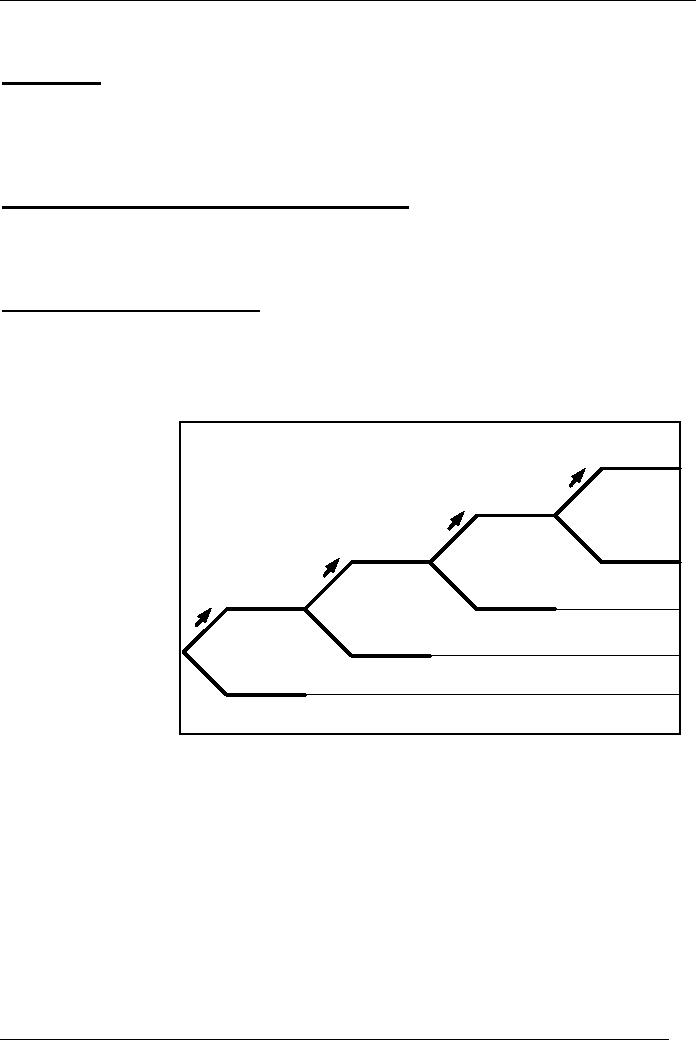 |

Brand
Management (MKT624)
VU
Lesson
32
CUSTOMER
RESPONSE HIERARCHY
Introduction
This
lecture looks into the
importance of understanding the
response effects as generated by
a
communication
campaign. The understanding of
these effects in relation to
developing a
strategic
communication framework is important.
What are the principles
that come into play
while
creating a brand-based communication
strategy will be discussed!
Awareness
and comprehension basic
denominators
Regardless
of the model, the starting
point of any campaign is
creation of awareness
followed
by
comprehension. Unless awareness is
created and comprehension developed,
message cannot
be
reinforced and, hence, communication
objectives cannot be
fulfilled.
Customer
response effects
CRE
As
briefly discussed in the
previous lecture, communication evokes a
hierarchical set of
customer
response
effects.
Building
Figure
40
awareness,
Customer
Response Effects
comprehension,
intentions,
and actions
are
all steps in
Action
ascending
order of the
90%
1
hierarchy
. This is
Intention
graphically
expressed
70%
here.
What
the
graphic
expression
Comprehend
No
action
amply
explains is the
10%
80%
fact
that all those
Awareness
No
intention
aware
of the brand
30%
75%
may
not translate that
Do
not comprehend
awareness
into an
20%
action
to buy. As you
Not
aware
move
along
the
25%
ascending
order of the
hierarchy,
you see
less
and less target customers
responding to the hierarchical
effects. If the target
population
consists
of 100 customers, then 75 of them
(75%) are aware of the
brand. Those who take
action
to buy are about 38 or 90%
of that 70% who intended to
buy.
It
is difficult to think of major brands
that have done well without
communications
advertising
in particular. We have to have
some level of communications
that we can control.
Therefore,
we can make three statements about brand
communications:
1.
Every brand must have
some means of communicating
with its buyers. The
way to talk
has
to be direct, if not
advertising.
2.
There can be many other ways
apart from advertising. The
message has to be new
and
interesting.
3.
All the means of communication and
the messages transmitted
must be coordinated to
make
sure they all talk about
the same thing.
These
fundamentals become the
basis of a brand-based strategy
for communication.
127

Brand
Management (MKT624)
VU
Brand-based
strategy
With
the understanding how
important is communication, we now
move on to building a
brand-based
communication strategy. Four
guiding principles to implement
the strategy are as
follows2:
1.
We have to use a combination of
all communication strategies to
realize our overall
strategy
and brand vision.
2.
We have to use the brand
picture and positioning as the
guiding force to determine
our
communication
strategies.
3.
We have to integrate the
communication strategies to use
the same message and
create
impact
all along the successive
stages of customer response
effects/hierarchy.
4.
We have to execute communication
strategies all across the
organization and create
internal
involvement for the success
of the strategies.
Must
couple the principles with
hierarchy
These
principles along with the
understanding of customer response
hierarchy give us
leads
into
determining the right
strategic framework for our
communications. It is here that we
decide
about the tools in relation
to their execution
properties.
We,
first of all, must be
mindful of the stage of the
hierarchy that may need
our attention. We
must
then determine the
objectives of communication according to
the stage of either
introduction
(awareness) or reinforcement to stimulate
comprehension and motive the
final
action
to buy.
Must
reach target customers along the
hierarchy
If
a marketing communication fails to reach
its target customers and
create awareness, the
successive
steps of the hierarchy will
not emerge. And, a business
will have to target
its
customers
at each successive stage of
the response hierarchy to
improve its performance.
Each
stage
lays the foundation for
the next stage. It may
call for repositioning or it
may demand
more
hammering depending on the
nature of the
campaign.
Two
classical examples enhance our
understanding of the above3.
Example
1
Ray-Ban
Challenge: The
sunglasses expert experienced decline as
the brand was
perceived
outdated and too limiting
being too masculine, and hence
not very
competitive.
The
strategy: The
Company challenged consumers'
perception by kicking off
a
campaign
with a renewed
brand persona and
positioning. The persona was
created that
of
modern, intelligent, appealing to
all, and hence confident
products.
The
result: The
contract was delivered not
only to men, but also to
women and younger
customers.
The company approached its
target market of existing users,
non-users, and
potential
users. Brand resilience brought it
back.
Example
2
BMW
challenge: 1997 was the
first year that the
company lost its number 1
position in
the
high-performance luxury car market. BMW
had no new launches in the
pipeline
whereas
competitors like Mercedes, Lexus, and
Infinity had many.
The
strategy: BMW being
aware of a strong brand picture
decided to
strengthen/reinforce
its existing
position with an
intensive communication
campaign.
128

Brand
Management (MKT624)
VU
The
result: BMW'
campaign "Ultimate Driving
Machine" brought the car back on
top
thus
solidifying its strategic
position.
The
first example of Ray-Ban relates
brand persona and brand
extension. The
company
identified
a few gaps (needs) that
could have been fulfilled.
It fulfilled those and created a
renewed
awareness about extending
its line proving in the
process their ability to
meet
customers'
perception.
The
other one relating BMW is sheer
reinforcement reminding the targets to
act upon
something
great they were not paying
attention to. It is a case of
sheer reinforcement.
Principles
of response hierarchy
These
two examples beautifully
explain the importance of
understanding the response
effect
hierarchy.
With the understanding to make
strategic adjustments in view of
the stages of the
response
effects, we now take a look at
the principles one by
one.
1.
Use all communication strategies to
achieve corporate strategy and
brand vision
All
possible tools or a combination of
communication tools are to be
used to achieve the
corporate
strategy and brand vision. Since
the overall strategy, the
vision, and the brand
vision
are all established already,
they give rise to compatible
communication
strategies.
Brand
managers must have the
management's commitment to exercise
strategic
execution.
Having had that, they should
be clear about when to
implement the
strategies.
The
amount of time needed to see
results depends on the type
of the market and the
amount
of resources employed.
The
important point here is not to
forget that we have to set
ourselves realistic time
limit
for
creating awareness, comprehension, and
action. Also, that it is
brand vision that
dictates
the strategy.
2.
Brand picture and brand
positioning help determine
the right strategies
The
image defines the actual associations
customers have with the
brand and the
persona
suggests the personality
traits customers think your
brand has. This tells
you
where
the brand stands.
If
the brand has not
been able to evoke the right
associations and customers do not
rightly
understand the persona then
there is a gap. You must see
where that gap is.
Only
that
will help you achieve the
intended position. You must fill
the gap in order to
fill
brand's
picture, fulfill its vision,
and achieve the intended
position.
The
gap is a reflection of not
being at the position that
you want occupied in
customers'
mind.
BMW's example reflects the
significance of this principle.
Another example that
illustrates
this principle is HP
printers4.
Despite
being at the forefront of
introducing variety of products, HP
lost its compatible
position
in the minds of the
customers due to decentralization of the
organization and
fragmentation
of communication strategies relating
the brand.
Getting
convinced (through sales
less than the goals)
that the brand was
underutilized;
the
company through research
reassured itself of the
positive associations customers
had
with the brand describing
its persona as innovative,
reliable, and scientific etc.
It
kicked
off a campaign emphasizing
the inventiveness on part of
HP. Campaign was a
huge
success.
129

Brand
Management (MKT624)
VU
The
gap between where the
brand was and where the
company wanted it was closed and
intended
position achieved. It looks
like a problem of not
talking the same thing
through
all
communications. This was due to
decentralization of the organization
and
fragmentation
of communication. Centralizing the
campaign in view of
the
homogeneous
profile of its customers, HP
centralized the campaign and gave
them a
reminder
of the persona they always
had in their mind. This again is a
classic example
of
reminding customers of good products and
reinforcing their intention to
buy those.
3.
Use an integrated marketing
communications strategy
Experience
has shown that advertising
and promotions when used
together create a
compound
impact. The reasons are
common sense-based. A mix of
all communications
has
a better chance of achieving synergy. If
synergy is to be achieved, then
advertising
and
promotions have to be mutually
consistent, so that they can
complement each
other's
effect.
Having
the two tools complement
each other leads to a
cumulative impact in the
minds
of
customers in a coherent way.
Fragmented messages at unrelated
times do not create
as
much of an impact as consolidated
messages through all the
possible vehicles of
communications.
The integration therefore
calls for certain methods to
be followed. The
generally
followed principles are:
Principle
of IMC (Integrated Marketing
Communication)
1.
Always look for
opportunities to blend various
possibilities of communication.
2.
Ensure that all of them
convey the same message,
consistently.
3.
Track all expenditure by
product, promotional tools, and
relate the observed effects
with
improvements
in future applications.
4.
Create a philosophy of capabilities and
cost effectiveness of each
tool.
It
forces you to consider all
the possible tools at your disposal to
communicate brand's
positioning
directly with your customers
by making sure nothing is left
uncovered.
The
question of budgeting
It
involves a very sensitive
question of budgets here. Before budgets
could be allocated,
you
have
to carry out situation
analysis - where we are and
why? This analysis has to be
related
with
objectives - what the brand
is aiming for in sales and
share?
On
the basis of these two
elements, the communication
strategy is crafted, which
means you
have
to determine what role
advertising and promotions will play?
Long term brand building
is
of
utmost importance.
The
appropriations are made in a
few different ways.
Methods
of appropriations
You
allocate resources as percent of
sales. Some argue this is
not good. This gives
the
impression
that sales drive
communications. In reality it is the
other way around. But,
this
remains
the most popular method of
appropriations. Once you
have the budget, you
must break
that
into allocations to different
tools advertising, promotions, and
any other.
Whatever
the budgets and further subdivisions
are, those have to be allocated to
the brand in
light
of the response effects and in
relation to all the tools of
communication. The tools
must fit
well
into the brand-based
strategies.
Summary
Understanding
of the response effect
hierarchy is of paramount importance.
Without that
understanding,
brand managers will not know
which stage needs emphasis
in terms of
130

Brand
Management (MKT624)
VU
communication
at a given point in time.
With this limitation present,
they will not be able to
formulate
the right communication
strategy. While making a
strategy, managers have to
be
mindful
of keeping in sharp focus corporate
strategy and vision, brand
positioning, and the
need
to kick off an integrated
campaign with a competitive
bite.
Bibliography:
1.
Roger J. Best: "Market-Based Management
Strategies for Growing Customer
Value
and
Profitability"; Prentice Hall
(300-303)
2.
Scot M. Davis: "Brand Asset
Management Driving Profitable
Growth through
Your
Brands";
Jossey-Bas, a Wiley Imprint
(157-177)
3.
Scot M. Davis: "Brand Asset
Management Driving Profitable
Growth through
Your
Brands";
Jossey-Bas, a Wiley Imprint
(156)
4.
Scot M. Davis: "Brand Asset
Management Driving Profitable
Growth through
Your
Brands";
Jossey-Bas, a Wiley Imprint
(159)
131
Table of Contents:
- UNDERSTANDING BRANDS – INTRODUCTION:Functions of Brand Management, Sales forecast, Brand plan
- INTRODUCTION:Brand Value and Power, Generate Profits and Build Brand Equity
- BRAND MANIFESTATIONS/ FUNDAMENTALS:Brand identity, Communication, Differentiation
- BRAND MANIFESTATIONS/ FUNDAMENTALS:Layers/levels of brands, Commitment of top management
- BRAND CHALLENGES:Consumer Revolt, Media Cost and Fragmentation, Vision
- STRATEGIC BRAND MANAGEMENT:Setting Objectives, Crafting a Strategy, The Brand Mission
- BRAND VISION:Consensus among management, Vision Statement of a Fast Food Company, Glossary of terms
- BUILDING BRAND VISION:Seek senior management’s input, Determine the financial contribution gap
- BUILDING BRAND VISION:Collect industry data and create a brand vision starter, BRAND PICTURE,
- BRAND PICTURE:Brand Value Pyramid, Importance of being at pinnacle, From pinnacle to bottom
- BRAND PERSONA:Need-based segmentation research, Personality traits through research
- BRAND CONTRACT:The need to stay contemporary, Summary
- BRAND CONTRACT:How to create a brand contract?, Brand contract principles, Understand customers’ perspective
- BRAND CONTRACT:Translate into standards, Fulfill Good Promises, Uncover Bad Promises
- BRAND BASED CUSTOMER MODEL:Identify your competitors, Compare your brand with competition
- BRAND BASED CUSTOMER MODEL:POSITIONING, Product era, Image Era, An important factor
- POSITIONING:Strong Positioning, Understanding of components through an example
- POSITIONING:Clarity about target market, Clarity about point of difference
- POSITIONING – GUIDING PRINCIPLES:Uniqueness, Credibility, Fit
- POSITIONING – GUIDING PRINCIPLES:Communicating the actual positioning, Evaluation criteria, Coining the message
- BRAND EXTENSION:Leveraging, Leveraging, Line Extension in detail, Positive side of line extension
- LINE EXTENSION:Reaction to negative side of extensions, Immediate actions for better managing line extensions
- BRAND EXTENSION/ DIVERSIFICATION:Why extend/diversify the brand,
- POSITIONING – THE BASE OF EXTENSION:Extending your target market, Consistency with brand vision
- DEVELOPING THE MODEL OF BRAND EXTENSION:Limitations, Multi-brand portfolio, The question of portfolio size
- BRAND PORTFOLIO:Segment variance, Constraints, Developing the model – multi-brand portfolio
- BRAND ARCHITECTURE:Branding strategies, Drawbacks of the product brand strategy, The umbrella brand strategy
- BRAND ARCHITECTURE:Source brand strategy, Endorsing brand strategy, What strategy to choose?
- CHANNELS OF DISTRIBUTION:Components of channel performance, Value thru product benefits
- CREATING VALUE:Value thru cost-efficiency, Members’ relationship with brand, Power defined
- CO BRANDING:Bundling, Forms of communications, Advertising and Promotions
- CUSTOMER RESPONSE HIERARCHY:Brand-based strategy, Methods of appropriations
- ADVERTISING:Developing advertising, Major responsibilities
- ADVERTISING:Message Frequency and Customer Awareness, Message Reinforcement
- SALES PROMOTIONS:Involvement of sales staff, Effects of promotions, Duration should be short
- OTHER COMMUNICATION TOOLS:Public relations, Event marketing, Foundations of one-to-one relationship
- PRICING:Strong umbrella lets you charge premium, Factors that drive loyalty
- PRICING:Market-based pricing, Cost-based pricing
- RETURN ON BRAND INVESTMENT – ROBI:Brand dynamics, On the relevance dimension
- BRAND DYNAMICS:On the dimension of knowledge, The importance of measures
- BRAND – BASED ORGANIZATION:Benefits, Not just marketing but whole culture, Tools to effective communication
- SERVICE BRANDS:The difference, Hard side of service selling, Solutions
- BRAND PLANNING:Corporate strategy and brands, Brand chartering, Brand planning process
- BRAND PLANNING PROCESS:Driver for change (continued), Brand analysis
- BRAND PLAN:Objectives, Need, Source of volume, Media strategy, Management strategy